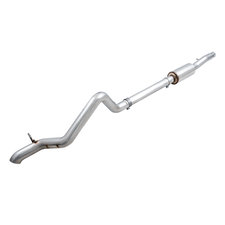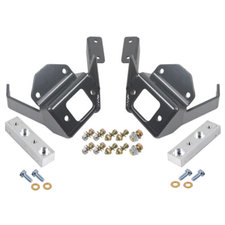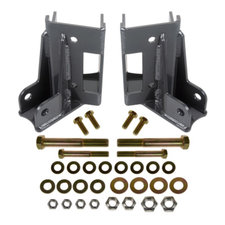by Scott Ammerman
Torque Correspondent
Slapping a new exhaust kit on your Jeep may seem like a useless mod unless your current kit has real issues. However, even if the existing version is fine, a new exhaust can help the engine work a little easier, provide a smidge more horsepower and even improve your off-road performance.
Recently, I was considering a replacement high clearance exhaust for Project Rattler, and in my research noticed there are quite a few choices in that market segment.
My Jeep sees a large number of trail miles every year, with no signs of stopping. I also do a lot of highway driving between different trail destinations, and herein lies the problem.
I’ve tried a few aftermarket high clearance exhausts, and have heard several more over the years. Because they are minimalist in design, there really isn’t a lot of room for an engineered solution that is strong and lightweight, but with the added benefit of ample ground clearance. One of the concessions I always thought I had to make was dealing with a reverberating droning sound at freeway RPMs — a price I figured I had to pay for the other boxes on the checklist being ticked off.
This line of reasoning continued for years, right up until the summer of 2021. Then, like a rocket, AWE entered the already crowded market with a full line of Jeep exhausts.

After researching the product line, I immediately started stalking the AWE Trail Edition Cat-Back Exhaust.
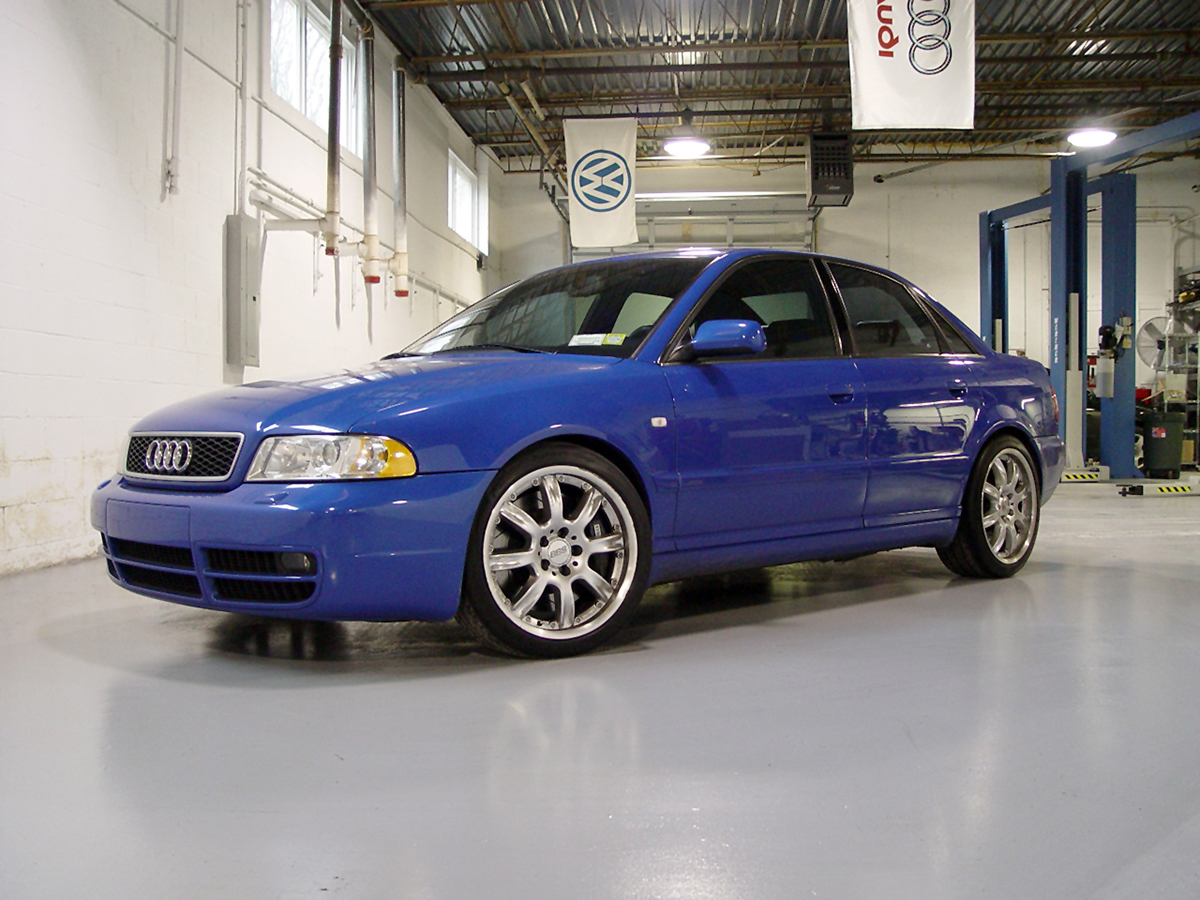
For the German performance market segment, particularly Volkswagen and Audi, AWE has been making exceptional products for over three decades. Because their exhaust kits are designed and built in the USA (Pennsylvania, in fact), the cost is relative to the exceptional standards they adhere to on all of their products. In fact, when I owned a VR6 powered VW GTI back in the early 2000s, and later a twin-turbo powered Audi Allroad, these were the exhausts I lusted after.
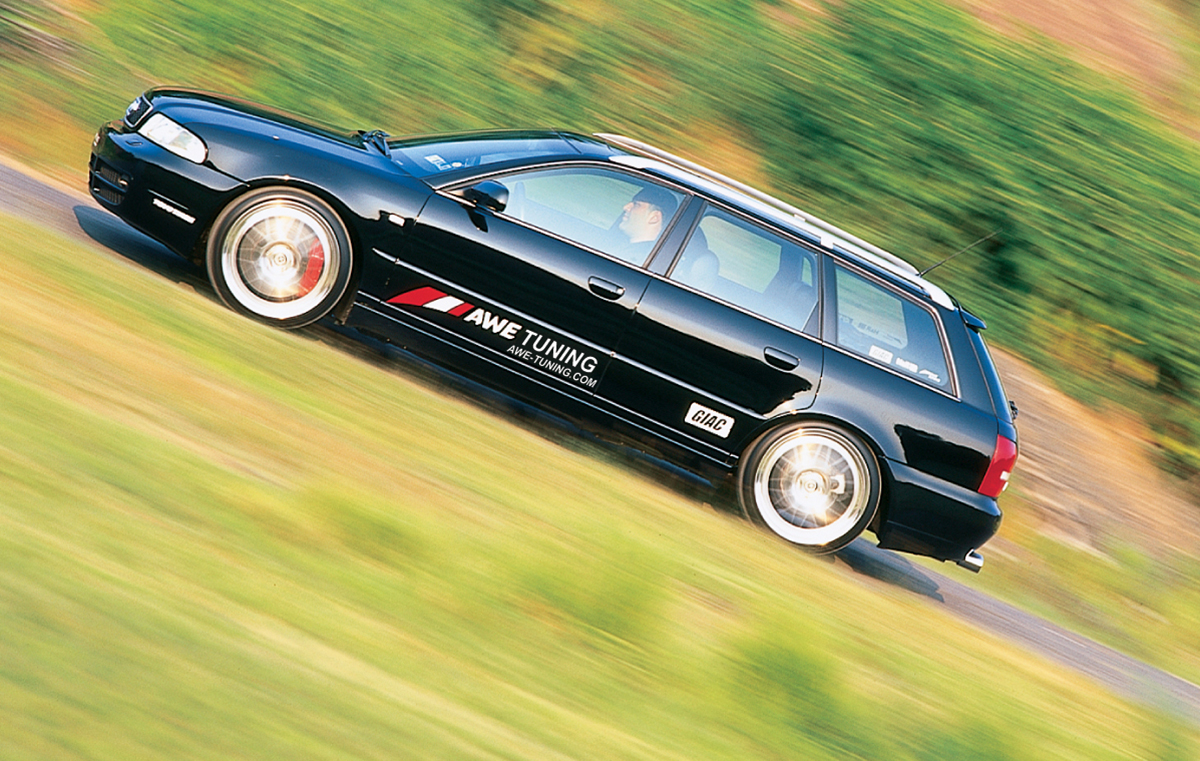
You could always tell the tone of an AWE exhaust as it passed you because of the nice throaty rumble at low RPMs, all the way up to the quarrelsome roar of a wide-open throttle pass at the track.
Our YouTube host Rob Jarrell and the video team visited the AWE facility in Horsham PA earlier this year and saw firsthand how the company unceasingly manufactures their exhausts to the same precise standards they have for years, but with even more state-of-the-art technology helping them push the envelope far past where their competition calls “good enough”.
The only real apprehension I had before installing the exhaust was going from a 2.5-inch system to the 3-inch diameter of the precision bent AWE design. I’m pleased to report that not only were there zero clearance issues, but the system actually tucks up higher than the one I removed, and doesn’t come into contact with any suspension components or relocated rear shocks. This added clearance has drastically improved my departure angles while descending off obstacles on the trail.
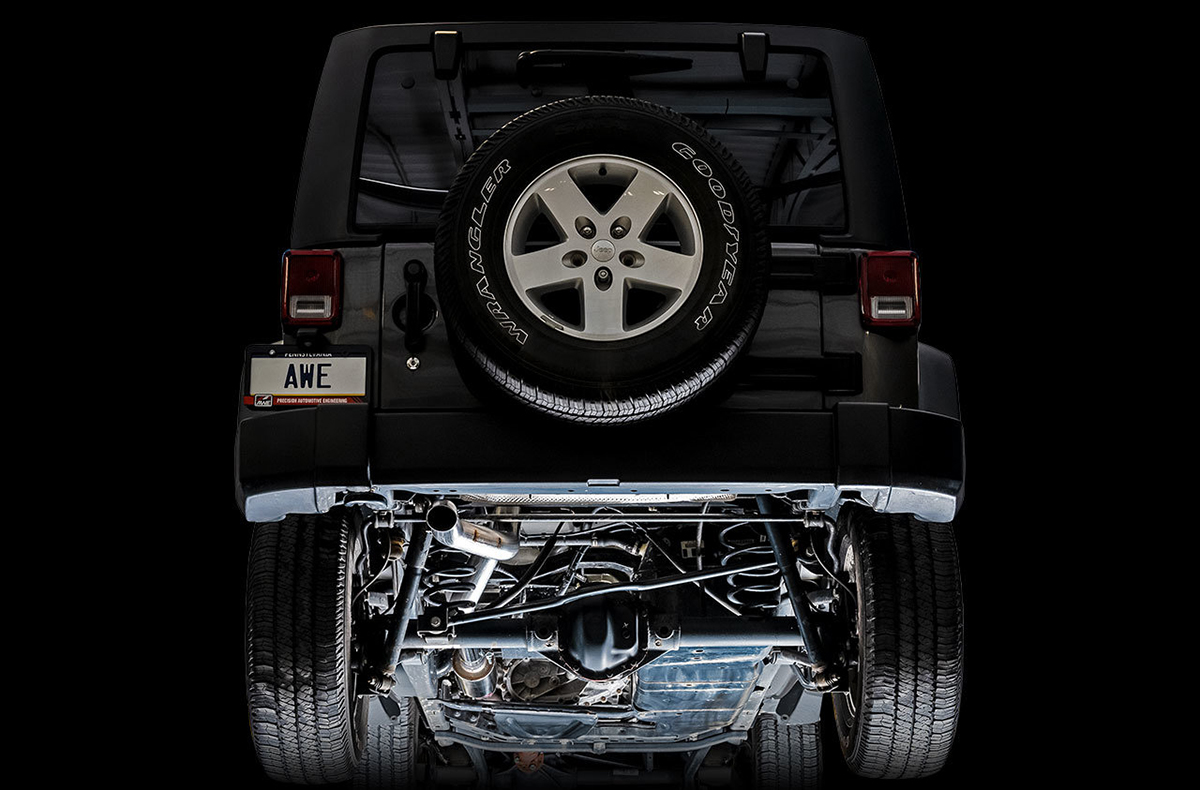
I’ll elaborate later, but for now let me say this — I have used this exhaust extensively for several months and during off-roading trips in Vermont, West Virginia and a handful of trail days at AOAA in Pennsylvania. I was prepared to compromise because it is a free-flowing and “low profile” system, and was willing to suffer through some additional noise output over the 2.5-inch system I was removing.
I could not have been more incorrect in my assumption.
Not only does this system sound DRASTICALLY better than the factory set up, but it also has zero drone when cruising at highway speeds.
All of the AWE Wrangler systems are manufactured using CNC mandrel-bent T304L stainless steel, which means they have serious corrosion protection and rugged durability. The Trail Edition is a cat-back system that replaces everything aft of the catalytic converter collectors and pipes, and the smooth precision bends boast a dyno-proven net gain of up to five horsepower and 10 lb-ft of torque at the wheels.
When unboxing an AWE exhaust, it almost seems more like a work of art than a mechanical upgrade. That’s because attention is paid to every aspect of the design, from the precise welds to the smooth stainless steel bends. You can tell this kit was built by a company laser-focused on quality, and not just slapping together a bunch of piping and “off the shelf” mufflers and tossing it out the door. This system carries a lifetime warranty and is guaranteed not to cause a check engine light.
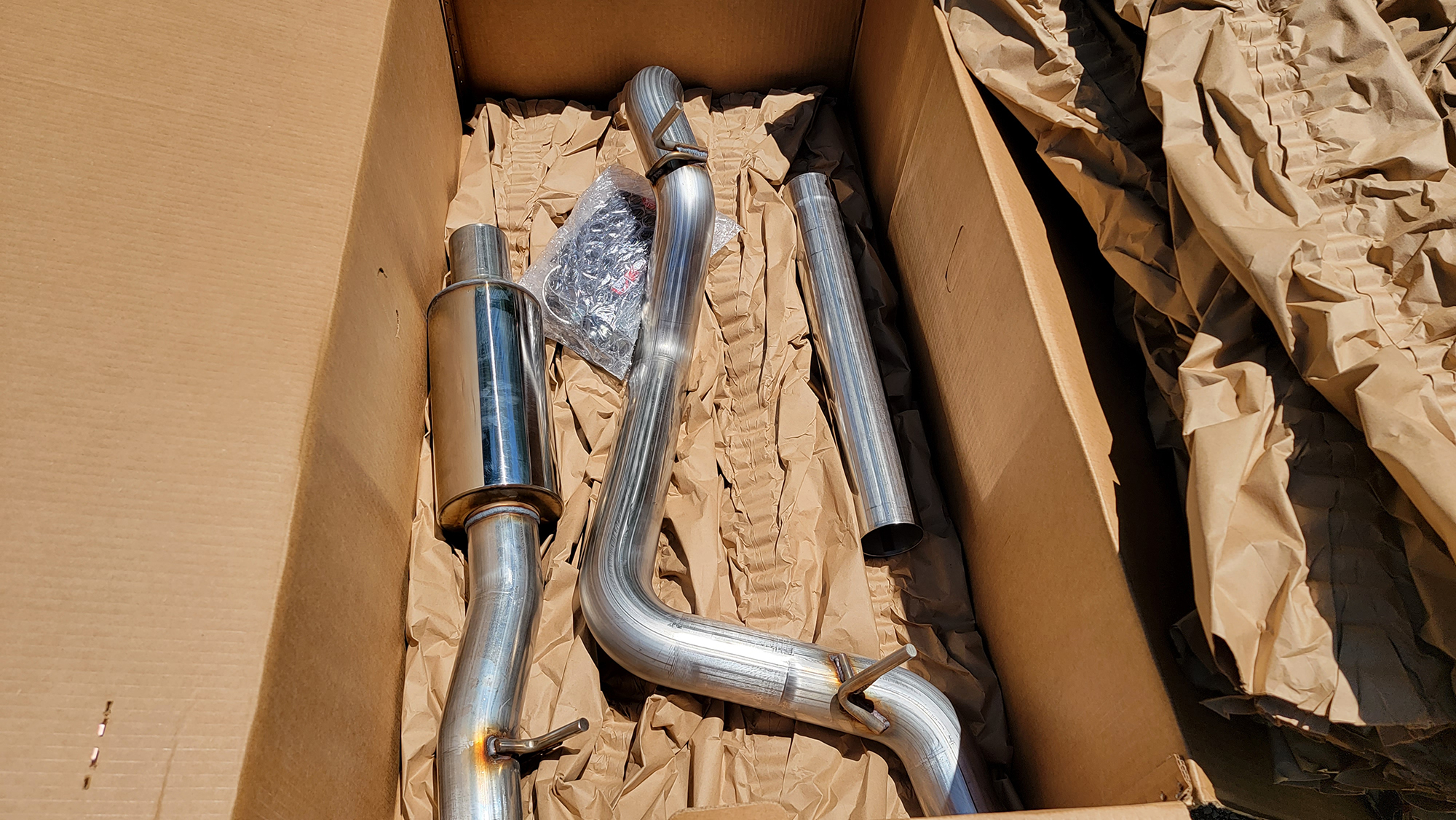
The AWE Trail Edition exhaust arrives in three large pieces, well packaged for the frequently rough shipping journey to your destination. The small parts are also secured well, so they can’t end up loose in the bottom of the box, or worse, escape to the outside world during transit.
I know this seems like a minor footnote, but that’s intentional.
As someone who has dealt with quite a few parts arriving with exploded hardware bags, this detail is not lost on me. Also, the clamps included in this system are legit, and made of 430 stainless steel that has just enough flex and ductility to get a nice tight seal.
If you’ve ever struggled with “el cheapo” clamps included in a lesser quality exhaust system, you know how critical these parts can be on a kit. When I took this picture, I didn’t realize how life-changing the parts in AWE’s plastic mystery bag would be, but I’m a HUGE fan. More on that coming during the last installation step, so make sure you read all the way to the end.
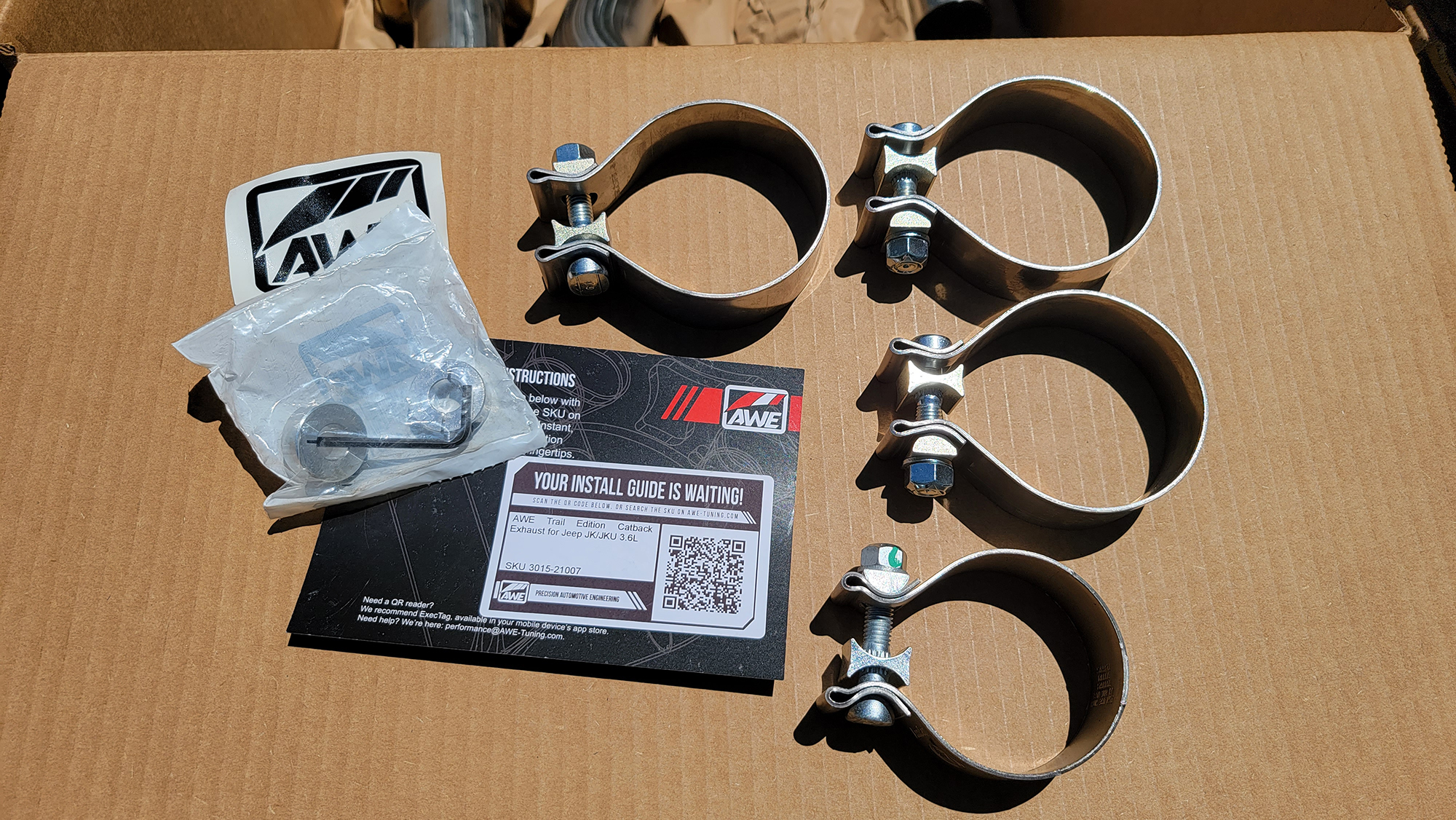
This job is easily done solo, in a driveway with a rolling creeper, and the hardest part is actually removing the factory exhaust. I highly recommend liberally spraying penetrating oil on the clamp hardware connecting the factory system the day before doing this upgrade. Actually, it's not a bad idea to do it several times that day if you are able.
Tools and materials required:
- 9/16” wrench (ratcheting box end worked great)
- 5/8” deep socket
- 15mm deep socket
- An impact wrench or air ratchet to compress clamps is recommended
- A long pry bar or flathead screwdriver
- WD-40 or similar penetrating oil
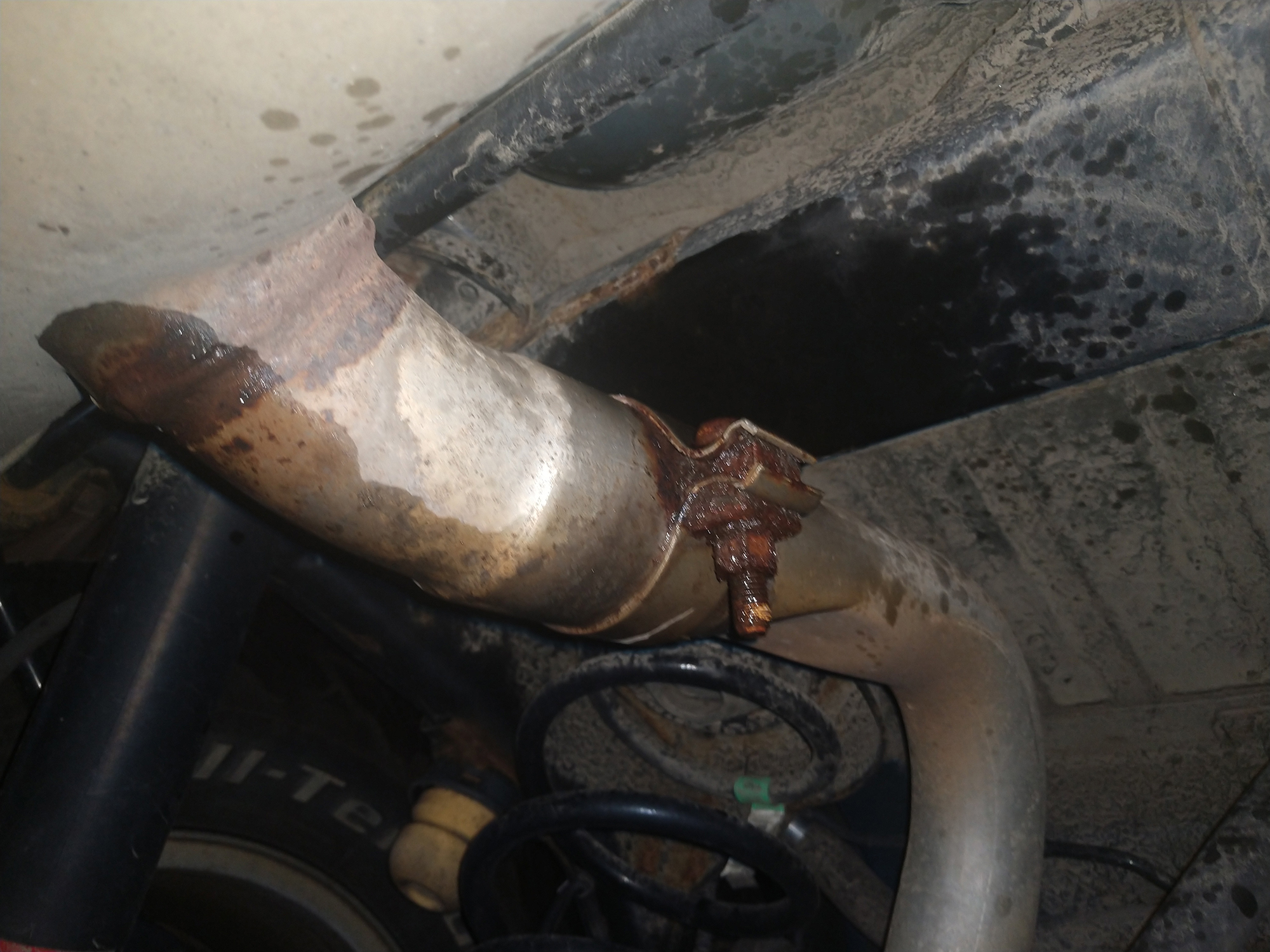
I was removing another aftermarket system to install the AWE Trail Edition system, so these next few pictures are from when I originally removed the factory components.
The factory system underneath your Wrangler is held together with two clamps and four isolators — on mine, the clamps were welded to the pipes and the front clamp had the nut on the top side, making it a little harder to reach.
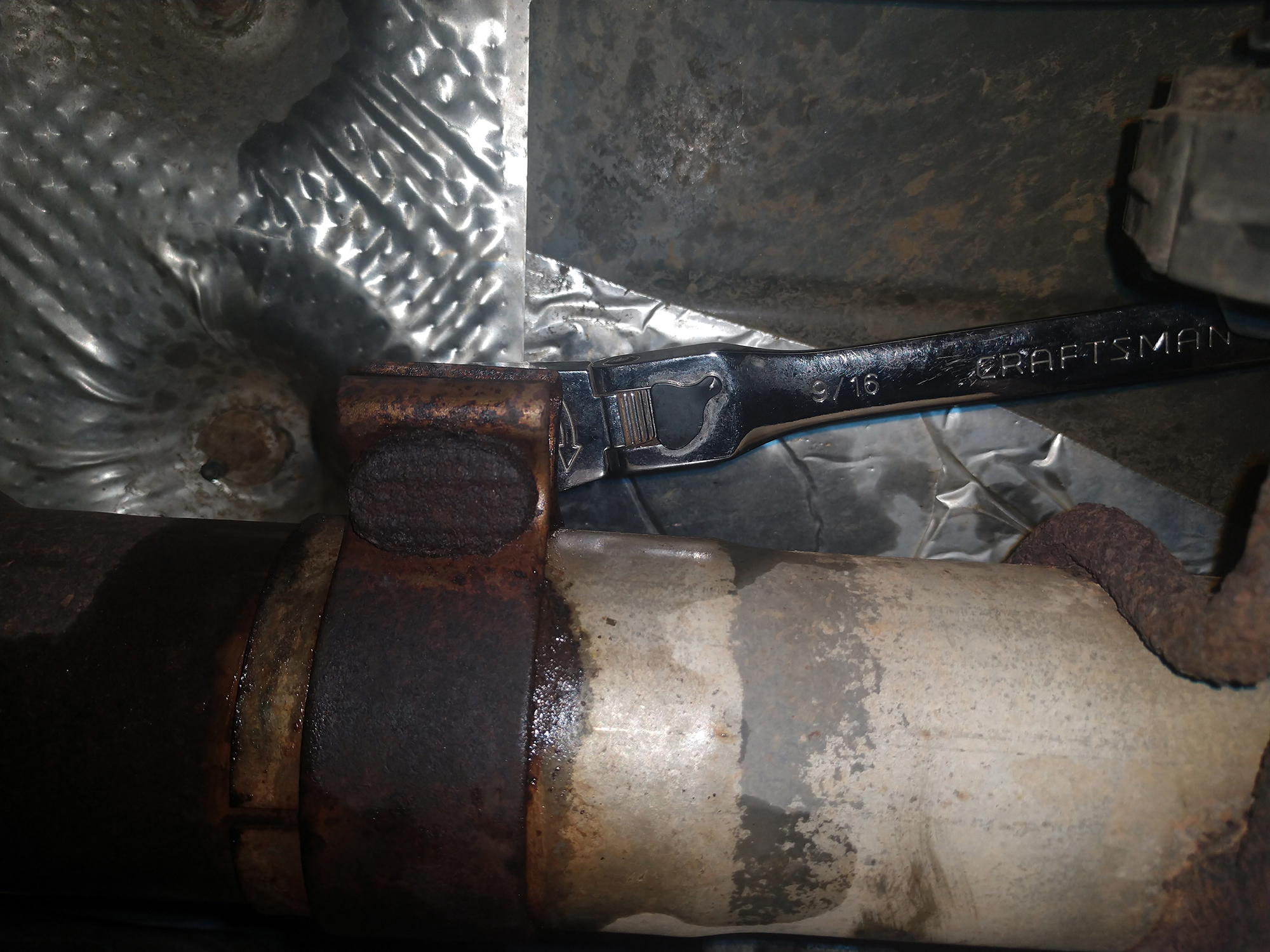
This clamp took a few minutes with the 9/16” wrench, a few clicks at a time. You don’t need to take the nut fully off, but definitely get it loosened up.
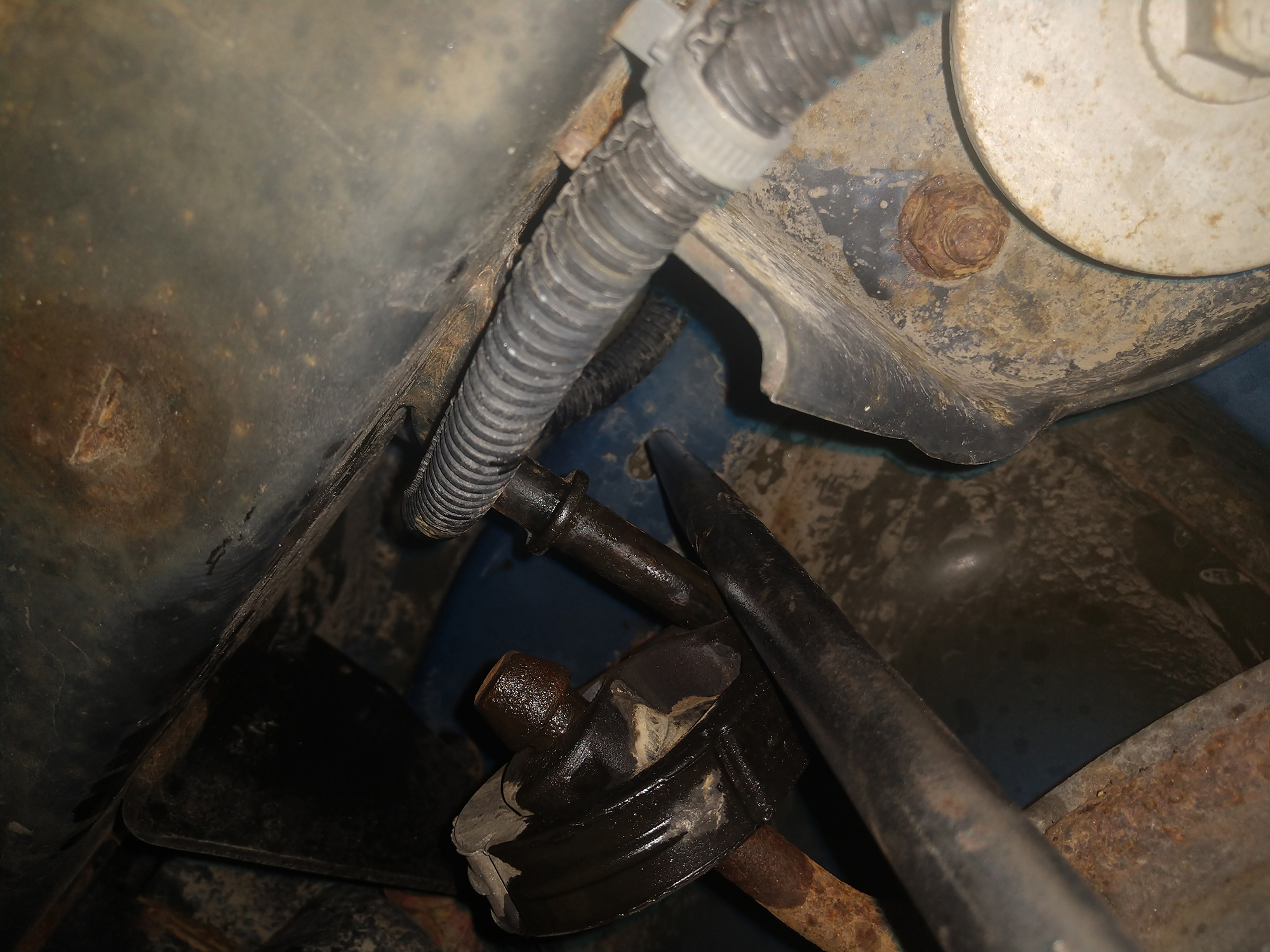
Above each of the rubber exhaust isolators are small holes in the body tub that I was able to use a prybar to work loose from the body side hanger rods. These rods get kind of scaly with rust, so spraying them with oil before removal really helps. The ones on the body side were less ugly, so I focused on those.
One important thing to note: Do not cut off these rubber isolators, as they will be reused with most installations. Then, with both of the hangers dislodged, use a ⅝-inch deep socket to remove the nut for the rear clamp. With luck, you can pull the muffler out by rotating it back and forth. For me, the process took a few minutes, and then I had the muffler on the ground.
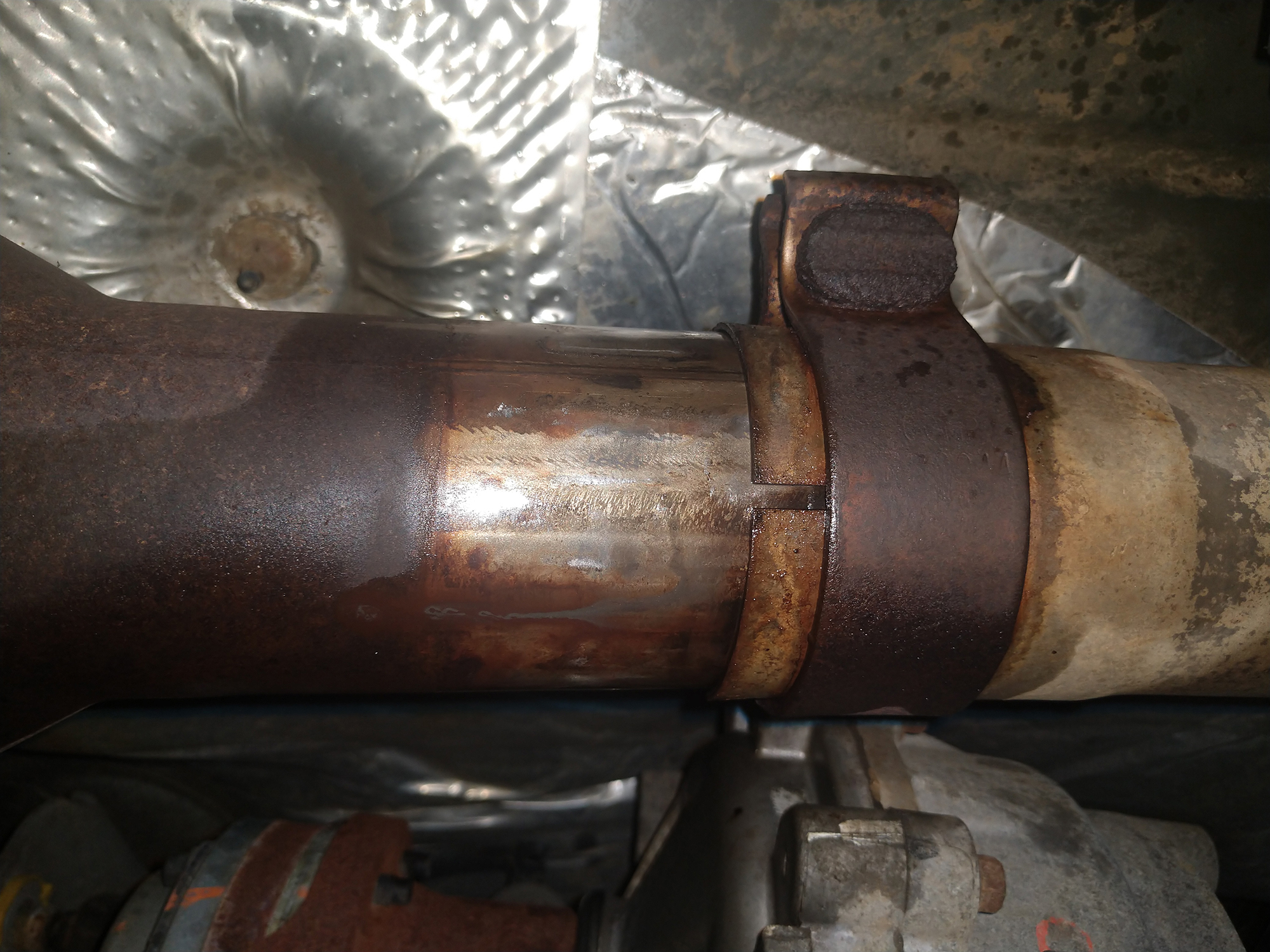
Also, because I loosened the front clamp, the other connection loosened as well — all the leverage with the old muffler broke it loose.
Even on a lift with my original removal, the exhaust system required a little more clearance to be removed without cutting because of the factory Rubicon transfer case skid plate. The easiest way to gain the extra room was to unbolt the evap canister’s shield. This may not be necessary with every removal, but if it fights you then it is not hard to get out of the way.
The skid plate could also be removed to gain clearance instead, but I’ve found those bolts more problematic than the ones for the evap canister.
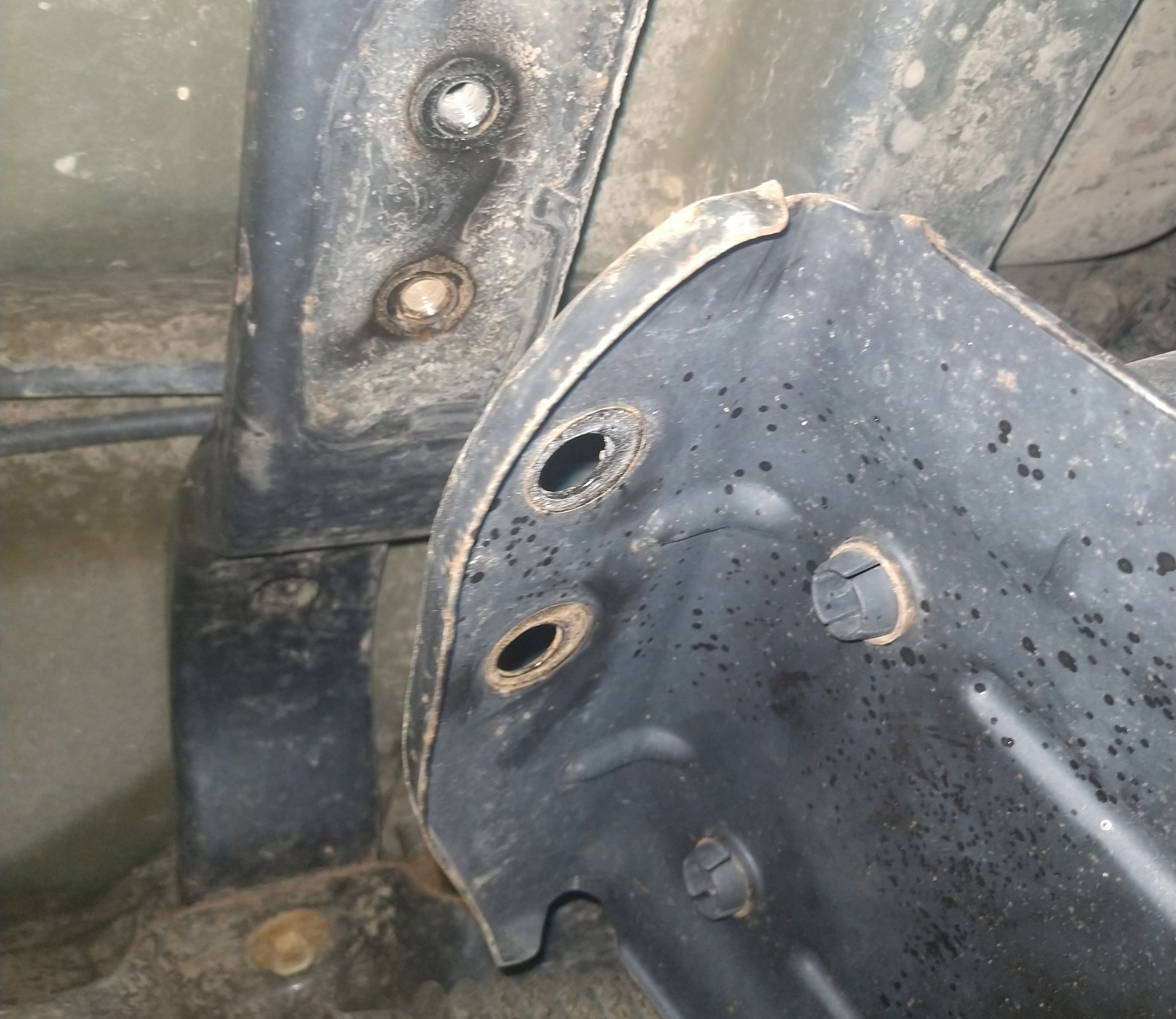
I have since relocated this canister up above the axle using the Rock Hard 4X4 Evap Canister Relocation Bracket which puts this fragile and exposed piece of emissions gear up high where damage is far less likely. This relocation kit works flawlessly with the new AWE exhaust systems as well, so this is something you may want to consider while you’re upgrading — particularly if you intend to spend a lot of time off pavement with your Jeep.

Now, with those factory components out of the way, you are very close to running what AWE rightfully calls the “Best Sounding Exhaust on the Planet”. Are you ready to be a believer?
Installation is a snap. The trick here is to snug up the clamps so they don’t slip around, but not fully tighten them so final adjustment is possible.
First, install the resonated front pipe and snugly install the clamp so it is accessible, but not hanging down. If you angle it upwards and have the bolt on the inboard side, it will provide a smooth profile if you end up coming in contact with something on the trail.
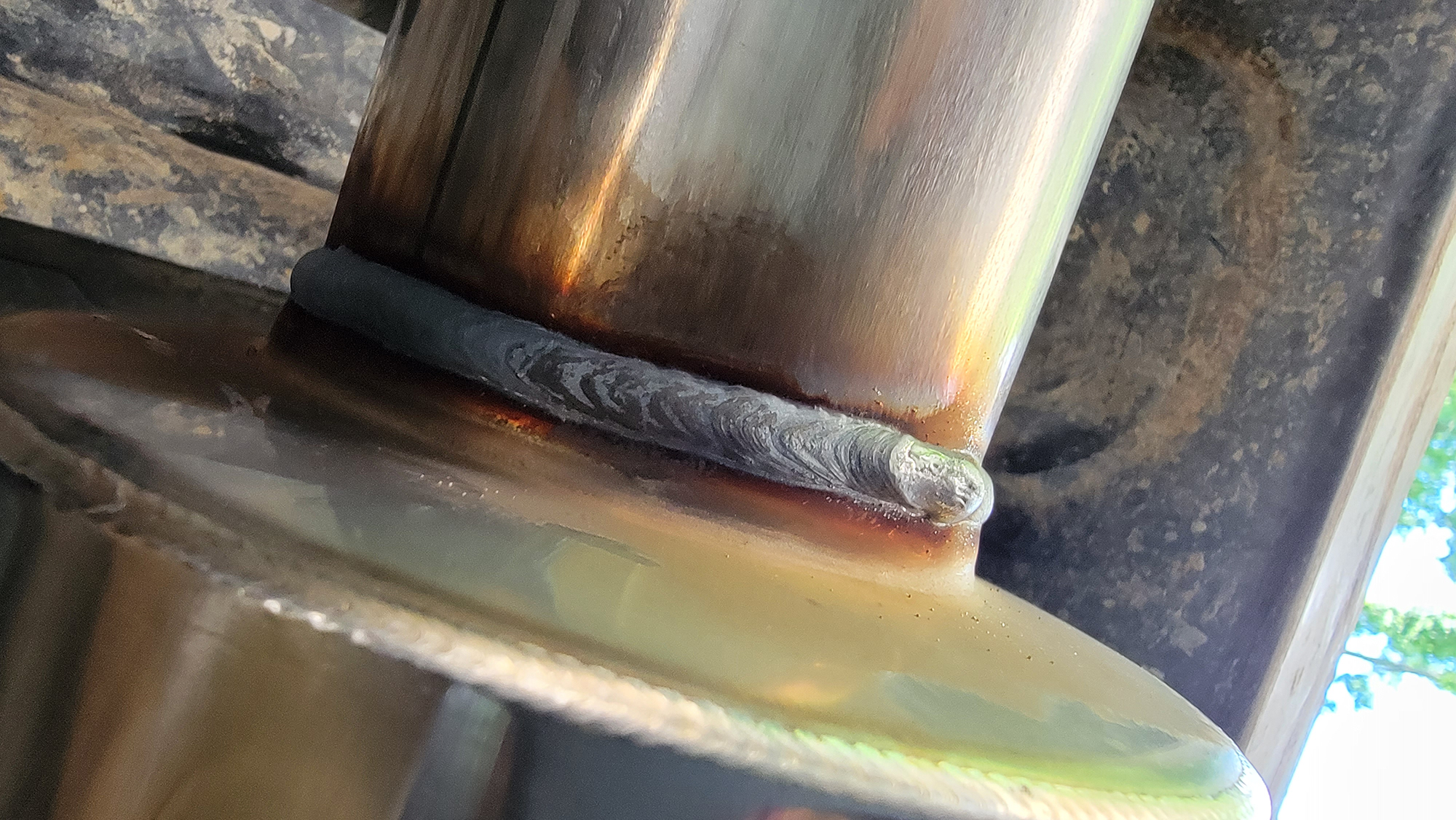
If you’re like me, you’ll take a moment to marvel at the artisanal grade welding on the resonator. I stared at this for longer than I’m comfortable admitting.
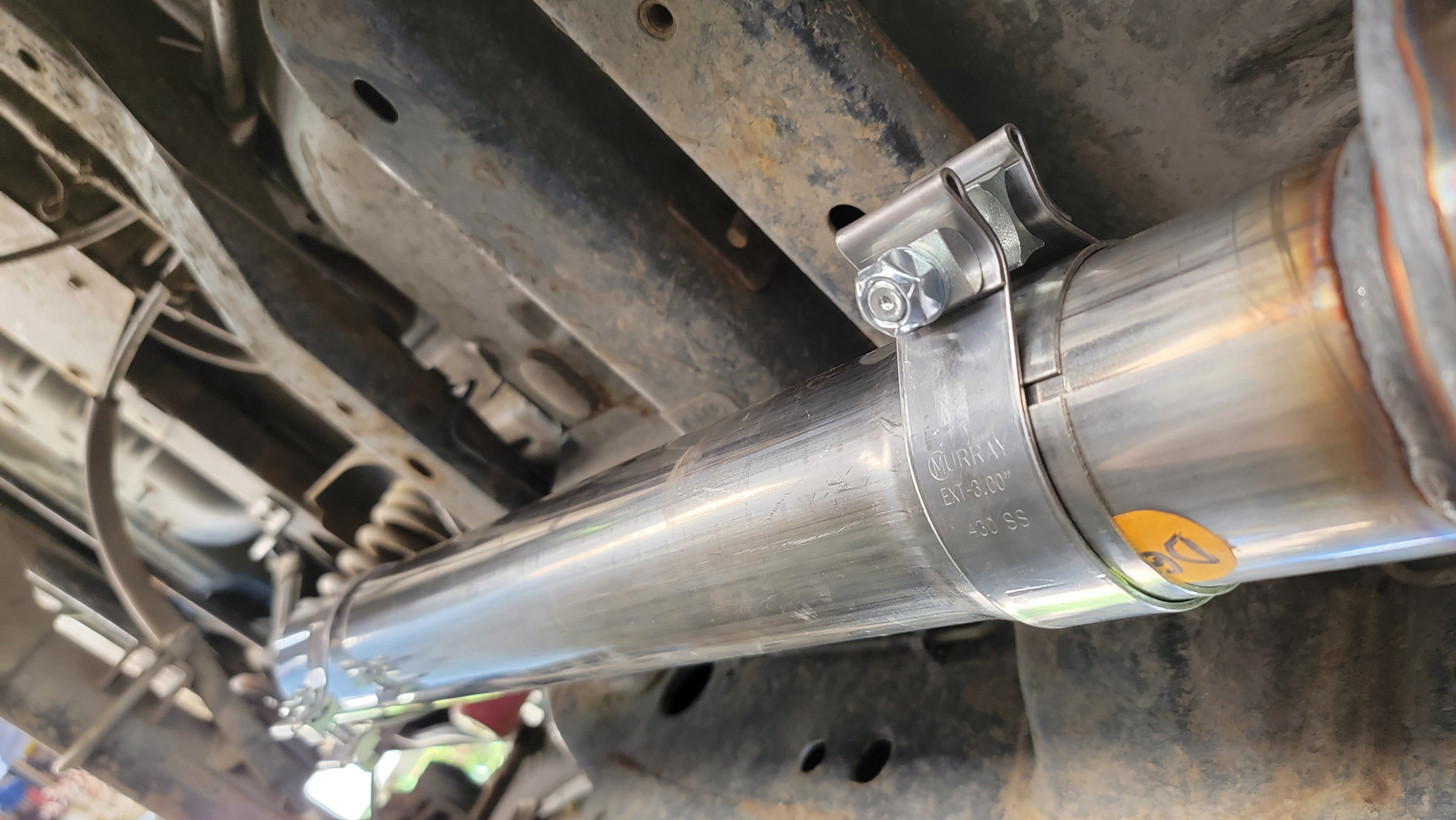
Next, use another clamp and install the mid-pipe. If you have a two-door JK model, this pipe is not included.
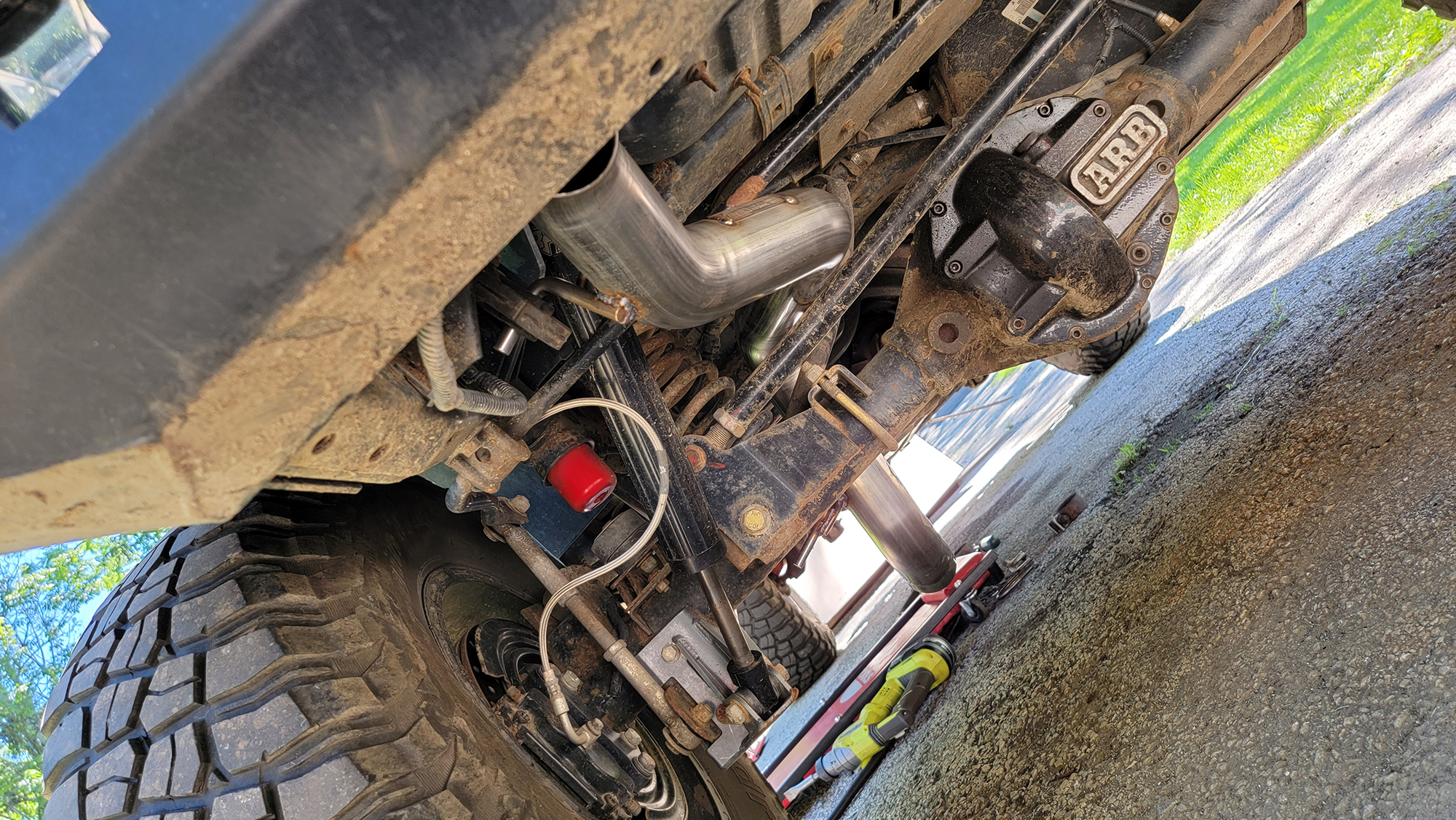
This next step is the only part that can be tricky with one person, but there is a method that works very well in the AWE instructions. Simply hang the pipe over the axle (from the back) and put the hanger bar through your factory rubber isolator. You’ll notice it slides in there smoothly, not like the rusty nub you had to push back through removing your factory system.

From there, go around to the front of the axle and put the second hanger bar through the isolator up high — you should then be able to easily connect it to the mid-pipe.
Making sure the exhaust hanger bars are parallel with the factory body side mount bars, tighten all the clamps to 60 lb-ft.
This fit is guaranteed flawless, because of that AWE badge.
And now, it’s mystery part time
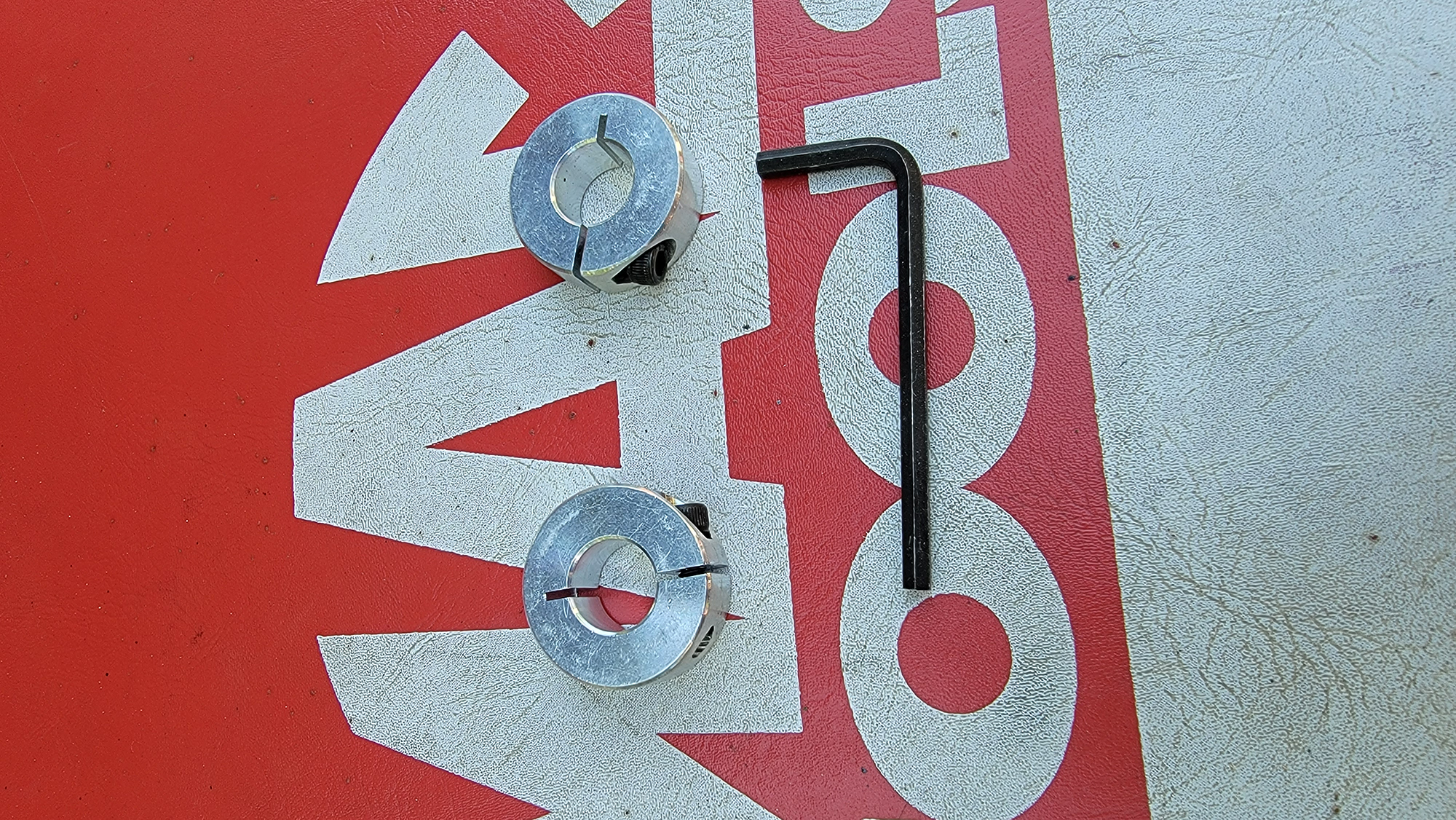
One of the biggest frustrations with any high clearance, single outlet system on a JK/JKU Wrangler is the hanger bars all point towards the passenger side. The only one pointing towards the driver’s side was on the passenger side of the factory muffler.
This means that if the exhaust system comes into contact with anything on the trail that pushes it towards the right, it can become dislodged. On my last few systems, this was a periodic annoyance, which required lying on my back in the dirt trying to put a hot exhaust system back where it belonged. Eventually, as a trail fix, I used a couple of metal zip ties to rig it back in place. It worked, but it wasn’t rock solid.
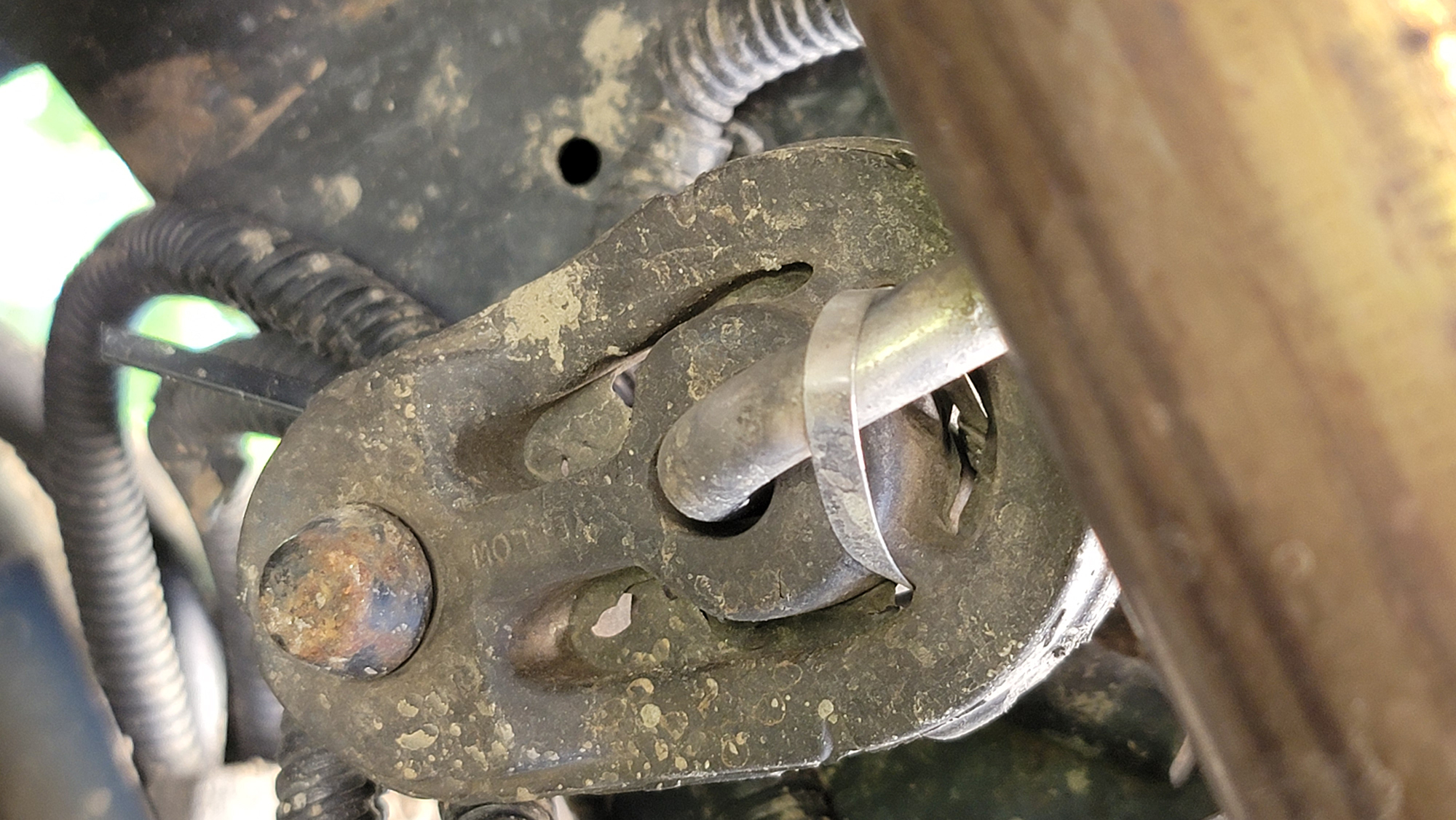
Of course, zip ties shouldn’t be used as a permanent repair. You know who you are.
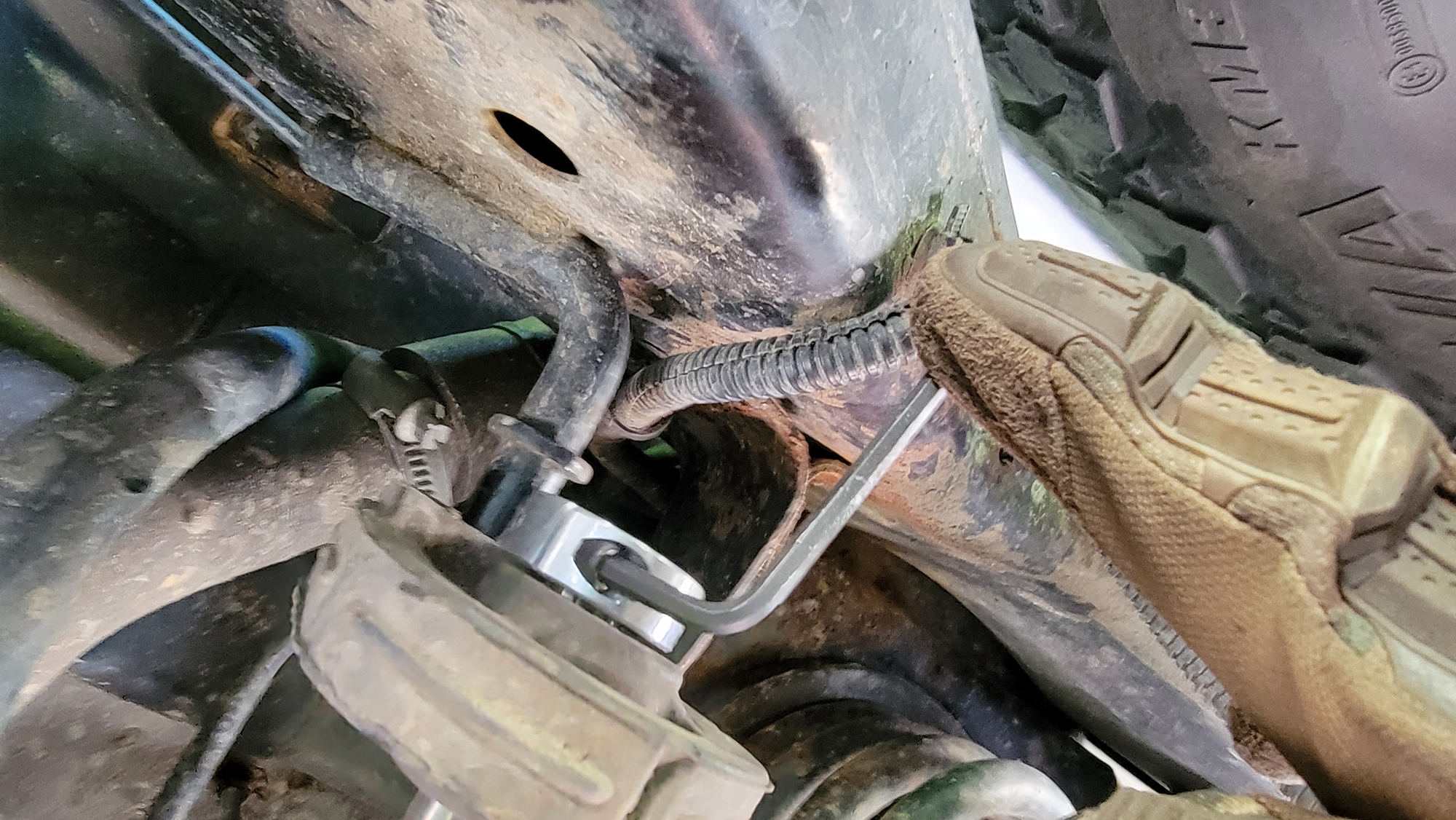
Well, AWE has completely solved this problem by including some amazing hanger bar collar clamps. Using the included hex key, install these over the Trail Edition System’s hanger bar, and tighten down. It makes the exhaust easier to install without a nub at the end of the hanger bar, which really doesn’t do much if they’re all pointing the same way.
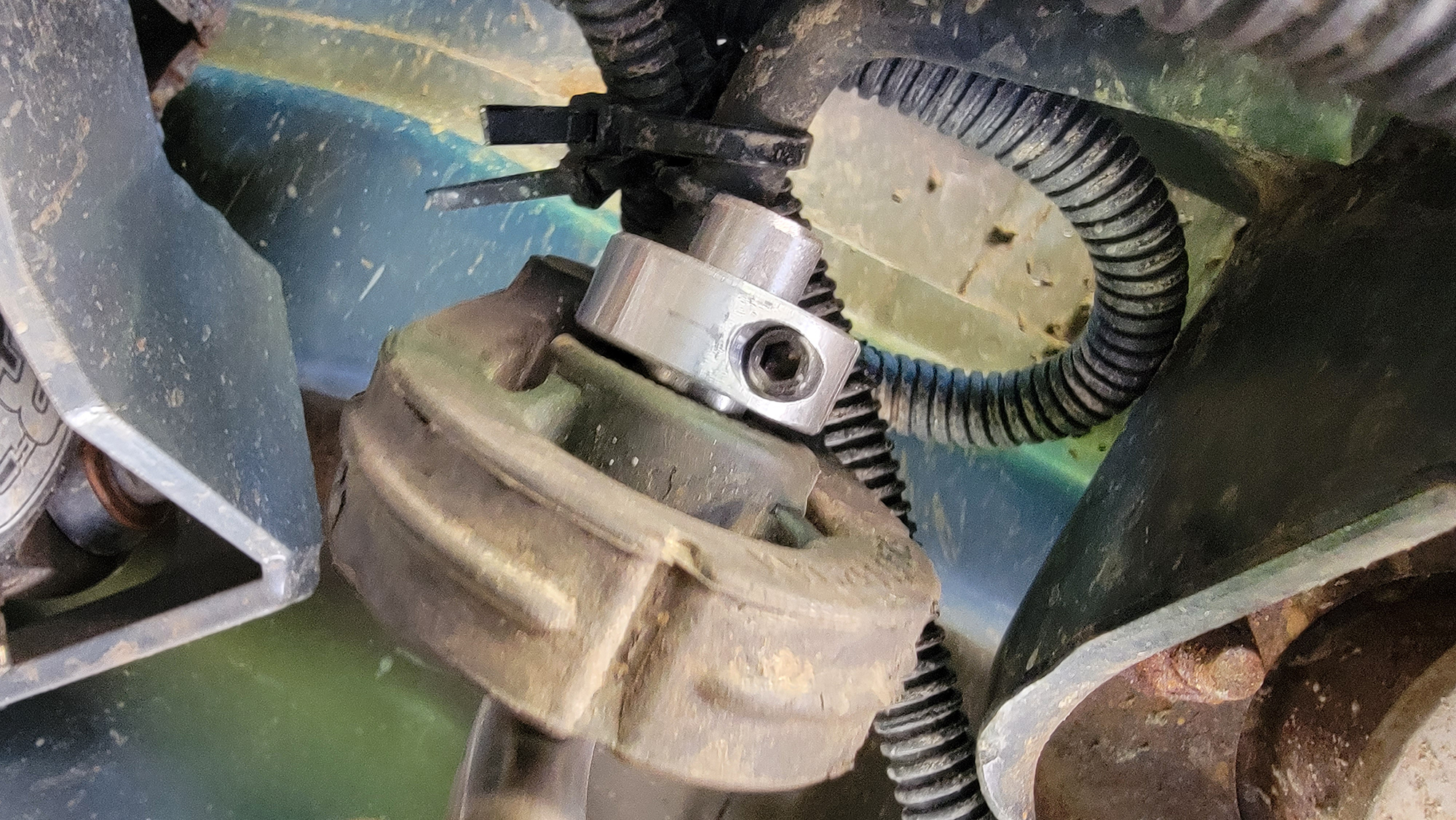
A couple of notes:
I already mentioned that it works well with the Rock Hard 4X4 Evap Canister Relocation Bracket.
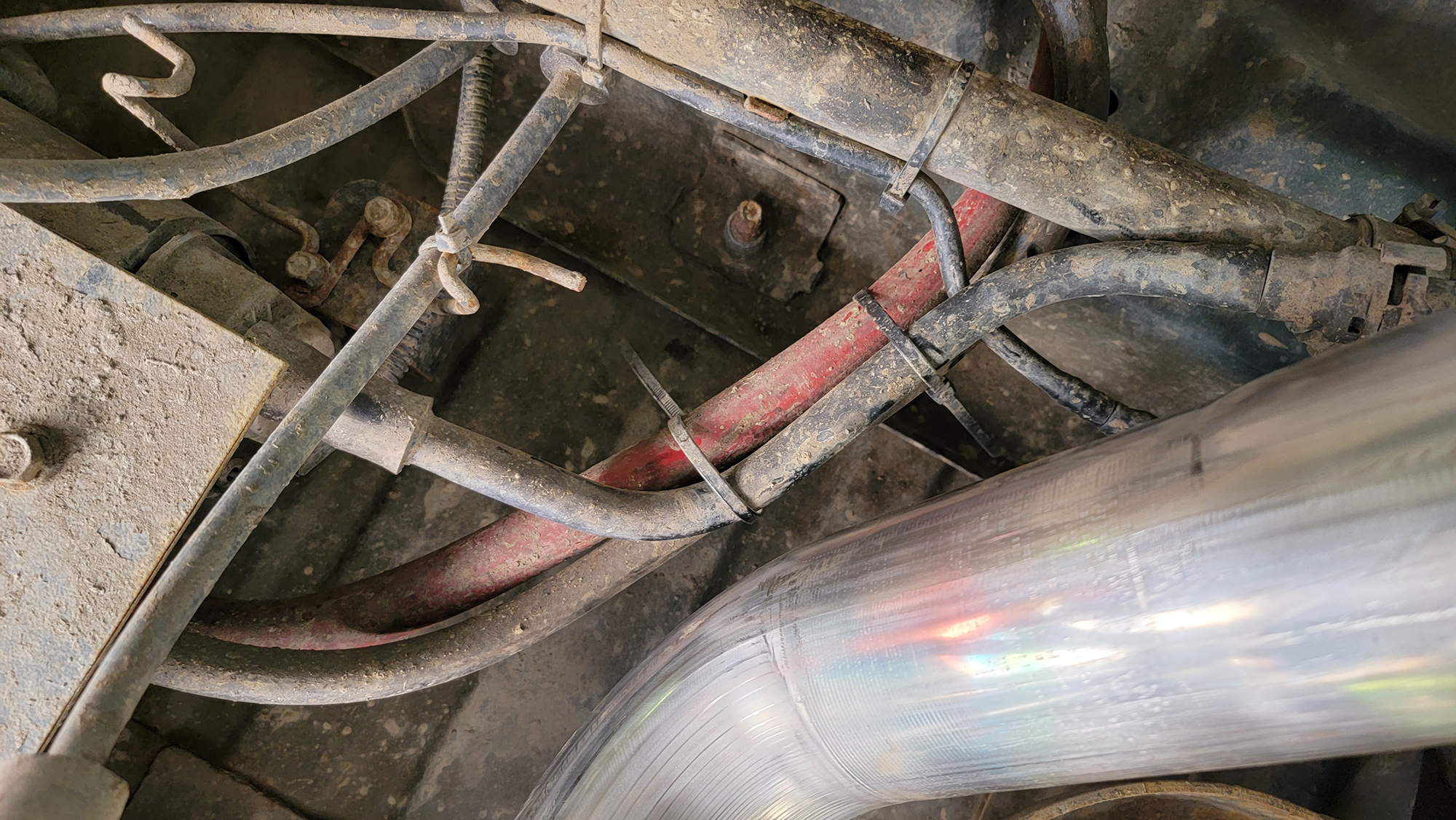
This exhaust also plays nicely with Synergy Manufacturing Rear Lower Control Arm Skids with Shock Mount and Synergy Manufacturing Rear Long Travel Upper Shock Mounts. This system moves the upper shock mount up and back, and raises the axle side shock mount up as well. This was a concern because the shock is in a totally different place, but the AWE Trail Edition exhaust flows right around it, with no clearance issues.
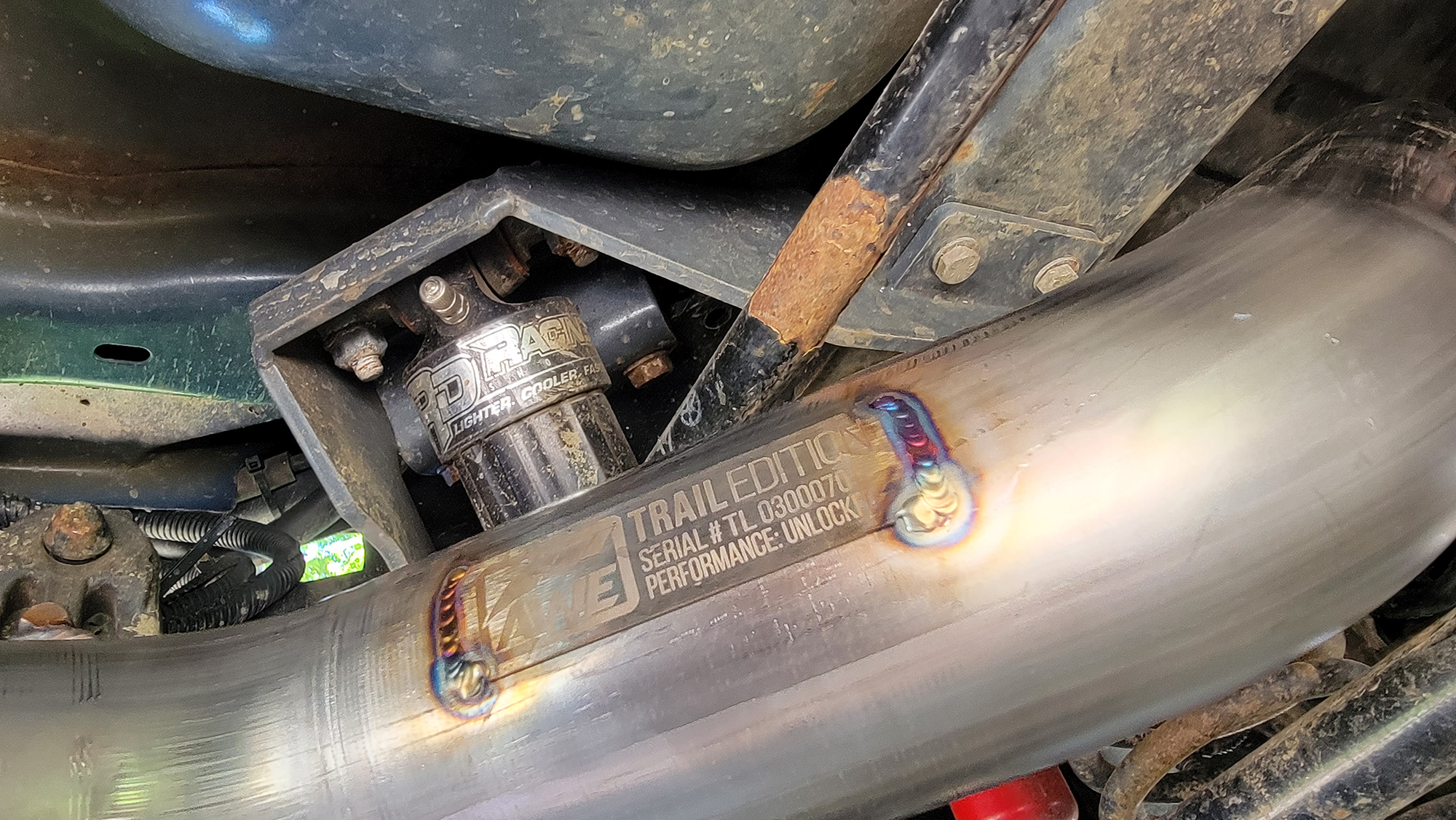
Additionally, the factory sway bar and axle have both been relocated one inch to the rear as part of the Rock Krawler X-Factory Mid Arm suspension, and did not create any geometrical challenges in this case either.
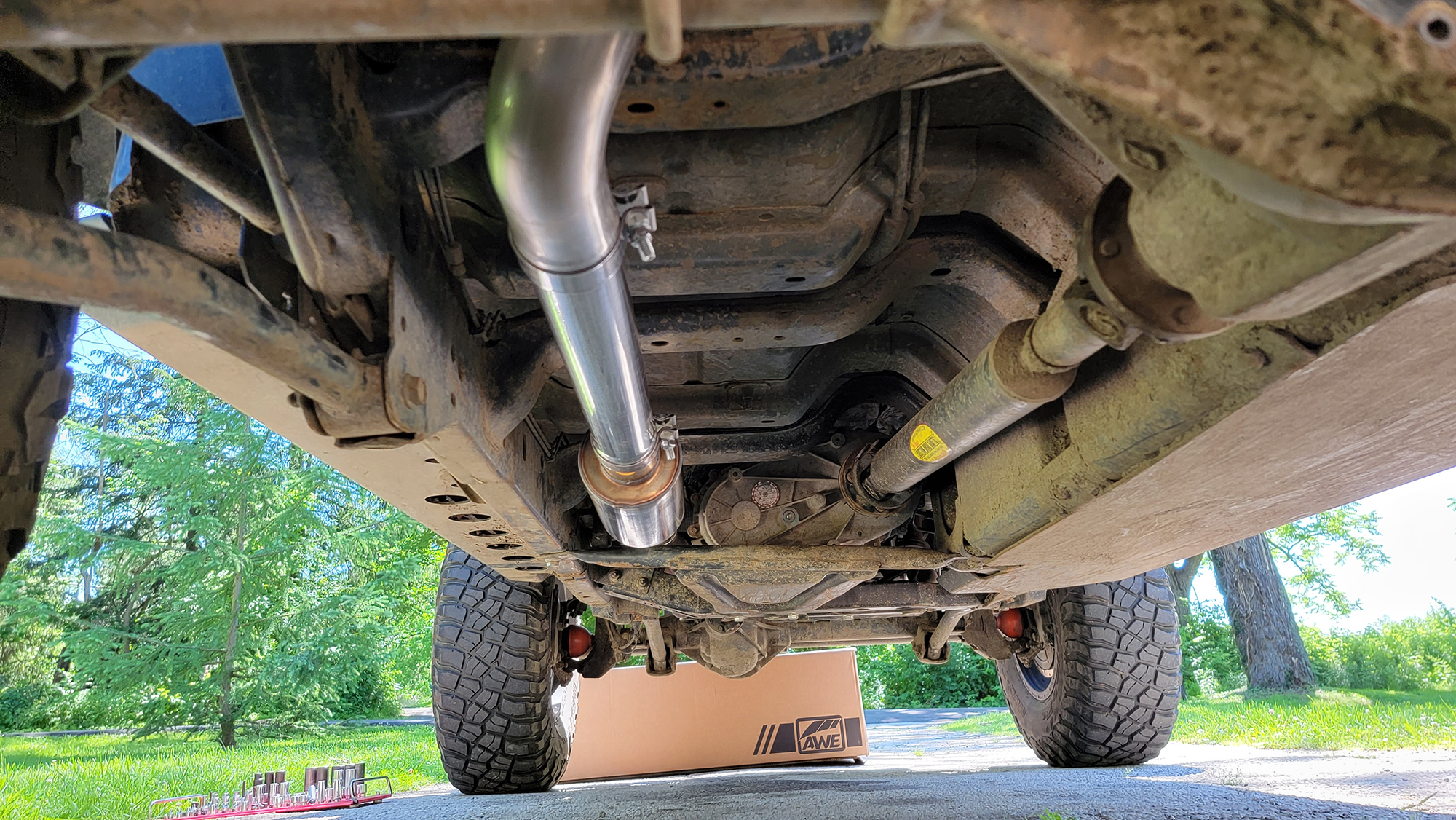
Exhaust systems are often overlooked, but the right setup is a visceral experience and this new AWE Trail Edition system is a particularly stunning example.
At idle, it has a soft rumble, but not to the point that you’ll have to shut your engine off when ordering at a drive-through. I know this isn’t a concern for every case use, but it's a good barometer of overall noise.
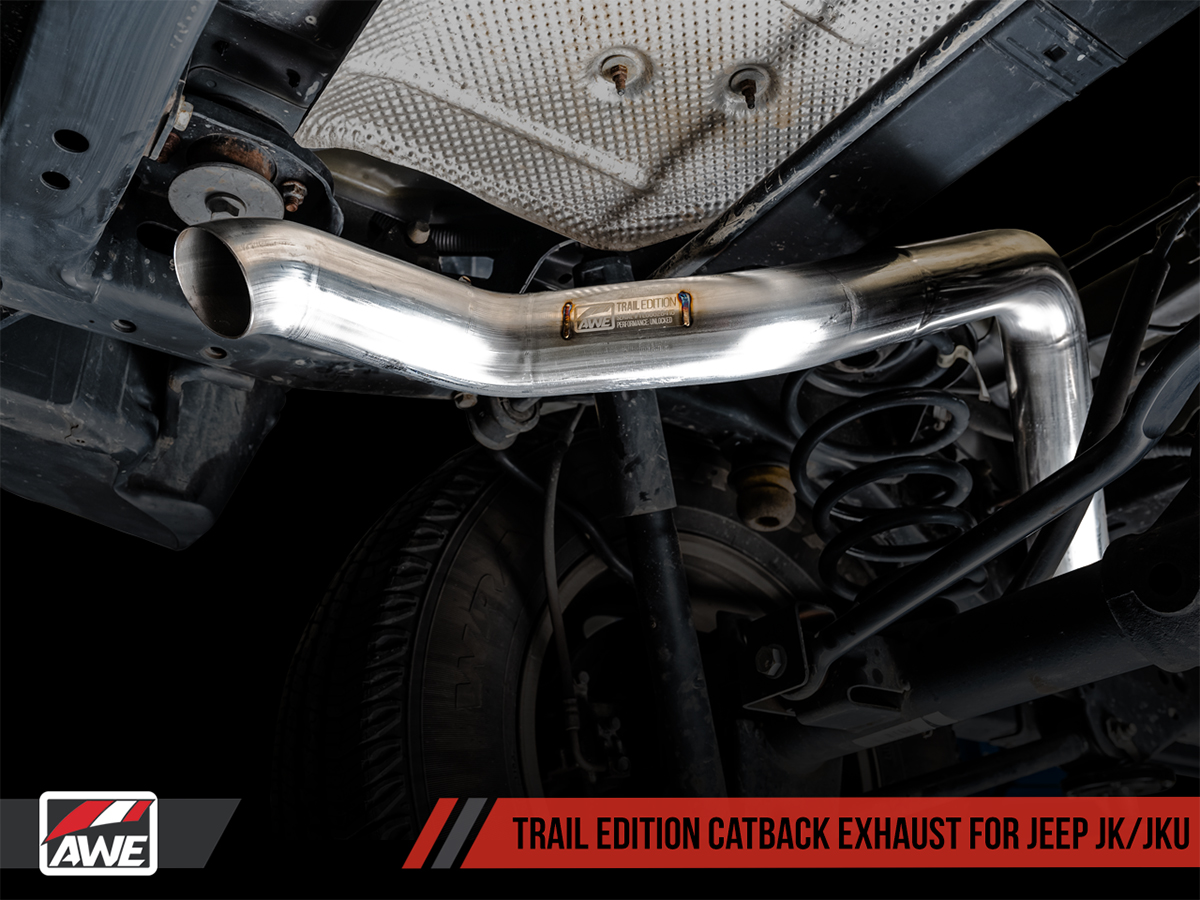
At low RPMs, cruising in a residential zone, it has a subtle note that lets you know a monster is lurking nearby — but it is not overly loud. If you’re looking to be the obnoxious “loud muffler neighbor”, this is probably not the exhaust system for you.
Now, when you floor it, the exhaust does sound like an upset grizzly bear trying to maul a tornado under your hood. You may never go through another tunnel again without instinctively mashing the gas.
On a high throttle off-road hill climb, this exhaust also opens up and screams. I haven’t done this type of trail more than a few times since installation of the AWE kit, but every single time someone has stopped me to ask what exhaust I use because they want one for themselves.
It doesn’t take a lot of skill to throw a basic exhaust system together; a few bends and a generic muffler will keep you legal and quiet.
However, it does take some engineering wizardry to make a four valves-per-cylinder motor with dual variable valve timing burp out some additional power, and literally sing while that happens. You don’t get good at that type of thing overnight.

If I had to pick an American company that set the gold standard in industry trends with the high-tech German performance market from the late 90s forward, it would unquestionably be AWE. I am ecstatic to see that to celebrate their 30th anniversary, they’ve applied everything learned while crushing that market to the newer Jeep offerings.
AWE is simply in the business of unlocking performance, and business is good.














